Preparation of spray solutions
For amateur flower growers, copper-soap solution and lime-sulfur broth are not always successful. To prepare the drug with high quality, the following technique is carefully observed.
For a copper-soap solution, take only warm soft water, preferably rainwater. If it is not there, add 5 g of soda ash or 2 g of dry mustard per 10 liters of water to soften the water. The solution should not be stored for more than 5 hours - it quickly deteriorates. The solution is prepared at the time of use in a wooden or enamel bowl.
In nine liters of hot (50-60 ° C) water dissolve 300 g of liquid green soap, in the absence of it, use 72% household soap. Then, 30 g of copper sulfate are dissolved in 1 liter of hot water.
In a hot state, a solution of copper sulfate is poured into a soapy stream in a thin stream. The place of contact of the solutions is immediately shaken quickly or the liquid is stirred with a wooden stick. The solution turns blue. Before spraying, the preparation is cooled to 20-25 ° C. If flakes fall out in the liquid, the solution cannot be used.
Lime-sulfur broth is prepared as follows. For 17 liters of water, take 2 liters of ground sulfur and 1 liter of good-quality quicklime (or 1.5 liters of slaked lime). Lime is slaked in a small amount of water, without bringing it to a violent boil. When the lime heats up, add sulfur to it and, stirring thoroughly, add the rest of the water. The mixture is boiled over a fire for about 50 minutes from the moment it boils until it turns cherry red.
During boiling, add water to the original volume. Stop adding 15 minutes before the end of cooking. The finished broth is cooled, defended and filtered through a canvas into a glass, earthenware or enamel dish. The strength of the broth is determined with a hydrometer. Usually its density is 1.152-1.162 g / cm3 (10-20 ° according to Baume).
For spraying plants take 180-220 g of ready-made broth (concentrate) per 10 liters of water. Two to three days before the start of treatment, a test spraying of one or two rose bushes is done. In the absence of burns on the plants, the solution can be used for spraying. In case of burns on the bushes, lime should be added to the solution. Store the broth in a well-sealed container in a cool dark place.
To prepare 10 liters of 1% Bordeaux liquid, you need to take 100 g of copper sulfate and 100 g of quicklime or 150 g of slaked lime. In one glass, earthenware, enamel or wooden dish, lime is quenched or diluted (milk of lime is obtained), in the other, copper sulfate is diluted. Then slowly, in a thin stream, with rapid stirring, a solution of copper sulfate is poured into a solution of milk of lime. The resulting mixture is called Bordeaux liquid.
You can determine its suitability for processing as follows: a knife or a nail, cleaned from dirt and rust to a shine, is dipped into the prepared solution. If the iron object removed from the solution is covered with copper, then lime must be added to the Bordeaux liquid until the plaque stops forming. To prepare 3% Bordeaux liquid, the amount of quicklime is respectively increased to 300 g, copper sulfate - also up to 300 g.
When to process
To treat apple trees with iron sulfate, it is important to choose the right time for the procedure, focusing on the vegetative characteristics of the fruit tree and weather conditions. Untimely spraying can lead to the death of the crop or the deciduous part of the plant.
Spring processing begins from the moment the snow melts and the beginning of sap flow in the tree trunk.After establishing a positive ambient temperature (+5 degrees in the daytime) and before laying the kidneys.
In early spring, the main attention should be focused on processing the bark of the apple tree, because it is in its cracks that numerous larvae and egg-laying of garden pests spend the winter. The second stage of processing begins after the opening of the buds
Its purpose is to protect the future ovary from fungal infections. After flowering, the next phase of spraying comes, which is a preventive one in the fight against adult insects.
The second stage of processing begins after the opening of the buds. Its purpose is to protect the future ovary from fungal infections. After flowering, the next phase of spraying comes, which is prophylactic in the fight against adult insects.
And finally, the final stage of processing apple trees with iron sulfate is carried out at the end of autumn, after the completion of leaf fall. It is also a preventive procedure, on the correctness of which the quality and quantity of the harvest in the coming season largely depends.
Processing roses before shelter for the winter
The processing of roses before the shelter is carried out with the help of copper sulfate and potassium phosphate fertilizers, which are familiar to all gardeners.
Chlorine copper oxide treatment
Compositions that contain copper are very diverse: it can be either copper sulfate itself or the equally popular Bordeaux liquid. Also, the processing of roses for the winter is carried out with a ready-made solution called "Champion", which can always be bought in special stores.
Root feeding with potassium-phosphate composition
There are ready-made complex fertilizers with potassium, intended for the autumn treatment of the root system. Such a composition can be prepared independently: 16 grams of potassium and 15 grams of superphosphate are dissolved in ten liters of water. For greater efficiency, it is recommended to use the "good old" dressing in the form of peelings from bananas, which are buried in the ground: the peel contains the necessary potassium.

Also, before you cover your roses for the winter, you can use one of two effective ways. In the first case, granules containing phosphorus are buried in the soil, and the earth around the bushes is sprinkled with ash (one glass will be enough). The second method is to mulch with well-aged manure. After such mulching, a glass of ash plus double superphosphate in the amount of two tablespoons is applied.
Fall dressing for roses and the activities that precede it are no less important than other measures for caring for delicate flowers. If all activities are carried out correctly, the plant will safely survive the winter, and in the spring it will again delight the gardener with continuous and abundant flowering.
Roses, processing before wintering:
Usage
The process of treatment and preventive treatment of roses occurs precisely with the help of ferrous sulfate. The most noticeable effect is in the fight against black spot disease. Works great and fulfills all its stated tasks during the fall season before covering the roses. It contains fifty-three percent of the active ingredients.
Before the actual use, it is imperative to make a three percent worker. For its manufacture, thirty grams of ferrous sulfate are needed, which are thoroughly dissolved in a small amount of water. The prepared preparation with the help of pure water must be raised to a volume equal to five liters. Usually, the drug is spent in use on roses of about ten liters per hundred square meters. It is recommended to apply the solution immediately.
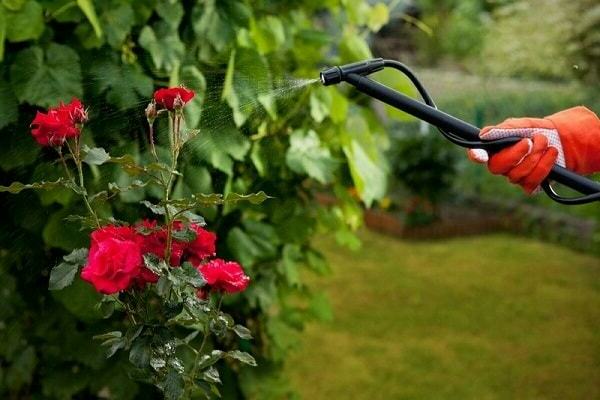
Purchase a spray bottle to work with the resulting solution. It is worth using a solution of ferrous sulfate only on days without winds, any precipitation and in the evening. Follow the weather forecast, as after applying the preparation containing ferrous sulfate, it is necessary not to wet the plant for about four to five hours. The solution will start working one hundred and twenty minutes after application.
The drug works for one to two weeks.
The use of the drug in the autumn season stops the processes of infection of various diseases in the winter season. Before applying the solution, it is worth destroying all the foliage from the plant. You should not allow air to the root system during the treatment with the solution.
It is worth digging up the ground. This will help to stop the process of contaminating the land. The advantage of this disinfection method is the absence of diseases and parasites for two years. The disadvantages include numerous foliage burns.
To combat the disease "powdery mildew" it is worth applying a preparation containing copper sulfate. In the processing in the spring season, diseases will not arise. It is worth repeating this procedure weekly (after the same number of days that have passed). Arrange processing prior to flowering. The use of a preparation containing copper sulfate in the autumn period should be in proportions: mix twenty grams of copper sulfate with nine liters of water with a small amount of laundry soap.
Advantages: the preparation is very cheap, the treatment of roses is easy to use and brings a quick positive result.
Disadvantages: numerous foliage burns, the solution is poison.
It is worth using this drug as a preventive procedure.
Prevention procedures and treatments
Diseases that are not infectious are the result of a lack or excessive amount of micronutrients. The positive result of the treatment process directly depends on the correct conclusion, what kind of disease the flower was infected with. Based on the type of disease, it is worth choosing a protection drug.
Each of the representatives of a huge number of varieties of the disease has its own specific qualities, knowing which, it is possible to instantly take measures to produce the correct treatment process. A positive result depends not only on a careful and correct choice of a means, method, but also on an instant reaction, because, having passed on to other varieties of herbaceous crops, it is unlikely that it will be possible to keep them healthy.
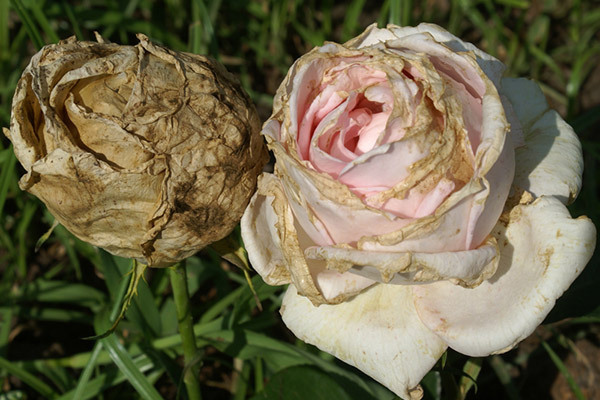
The most famous and common diseases are common rust and fungal disease. For the procedure for the prevention and treatment of these types of diseases, it is worth buying vitriol in a store with a garden theme or in an ordinary supermarket in the household chemicals department. You can purchase both copper sulfate and iron sulfate.
It is the most used and effective fungicide with a wide variety of uses, such as stopping the growth of fungal diseases.
The growing disease of the fungus stops the destruction of this plant. Ferrous sulfate is a part of ferrous sulfate. It is used as a fungicide or soil fertilizer. Copper sulfate is a part of copper sulfate. It is used as a fungicide.
Why process
For this purpose, it is convenient to use a time-tested remedy called copper sulfate. Since roses are not resistant to various diseases, it is better to carry out treatment for prevention, constantly.
An integrated approach, including processing in autumn and winter, will eliminate the development of dangerous diseases that provoke the death of the shrub.
Each rose in the garden has its own story: one came from distant lands, the other was grown from a cuttings, the third was donated by a loved one. Naturally, we are worried if our favorite flowers are sick. Most often this happens in late summer - early autumn. Fortunately, there are tools to deal with the adversity.

A well-kept rose garden is the main decoration of any garden plot. But the "queen of flowers" is gentle, vulnerable and capricious, as befits a royal person.
It has many natural enemies, among which the most dangerous are fungal infections that can kill more than one plant in a short time.Prevention here is many times more effective than combating the spread of the disease, since it is difficult to identify all its foci.
One of the most effective measures is recognized to be the treatment of roses with iron sulfate in the fall, before sheltering for the winter.
The fungicide will prevent fungal spores from multiplying, which form in a humid environment under fallen leaves or polyethylene, which protects the flowers from the cold.
In the spring, when the protective winter coating is removed, rose bushes should be additionally sprayed with copper sulfate, then they will be reliably protected from fungus and will be able to delight with a healthy look, as well as lush, long flowering.
The queen of the garden, the rose, is not ignored not only by the person. Numerous diseases, pest attacks damage the health and beauty of gardeners' favorite
The rose is especially vulnerable in early spring, since it has weakened over the winter.
Therefore, it is very important to process roses with high quality after winter in order to prevent infection of the bushes with infections, to protect them from the first hungry pests. For successful wintering, roses are fed in autumn with potassium-phosphorus fertilizers and sprayed with anti-infection agents
Even if the roses look healthy, preventive measures are needed. After all, the disease does not manifest itself instantly, the infection lasts 2-3 weeks, so it is dangerous to count on luck. Roses heal with purchased fungicides and folk remedies
For successful wintering, roses in the fall are fed with potassium-phosphorus fertilizers and sprayed with anti-infection agents. Even if the roses look healthy, preventive measures are needed. After all, the disease does not manifest itself instantly, the infection lasts 2-3 weeks, so it is dangerous to count on luck. Roses are healed with purchased fungicides and folk remedies.
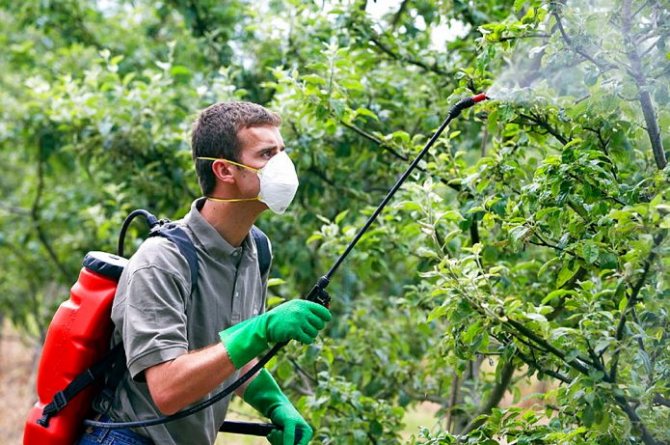
When treating plants, protect the respiratory system with a mask, and your hands with gloves, take a shower after spraying
Autumn treatment of roses with iron vitriol is aimed at:
- protection of plants from freezing in winter;
- preventing the appearance of pests;
- protection from rodents;
- prevention of fungal diseases.
In addition to spraying, of course, roses will also have to be well covered for the winter. Only in this case can you be sure that the shrub will safely survive the cold.
Let's get acquainted with the basic rules for processing roses with iron vitriol in the fall.
Spraying with copper sulfate in the fall
When asked whether it is necessary to process the garden with copper sulfate in the fall, the gardening manuals answer in the affirmative. In anticipation of cold weather, insects hide in the bark of trees, on branches, in the ground next to the roots. Processing the garden with copper sulfate in autumn allows you to destroy single individuals and entire colonies in places where they concentrate, preparing for hibernation. It is necessary to spray the cracks in tree trunks and bark, branches, soil next to the plant.
Proportions
Experienced gardeners give precise recommendations on whether it is necessary to treat the garden in the fall with a solution of copper sulfate and how to properly prepare the solution. The working fluid should consist of 100 g of powder and 10 liters. water, this amount of solution must be distributed over an area of 100 sq.m. When apple trees are treated, the consumption of the drug is 2 liters per tree. In a solution of this consistency, you can soak the bulbs or tubers of plants before planting. To process apricots, drainage requires 50 g of copper sulfate per 10 liters of water.
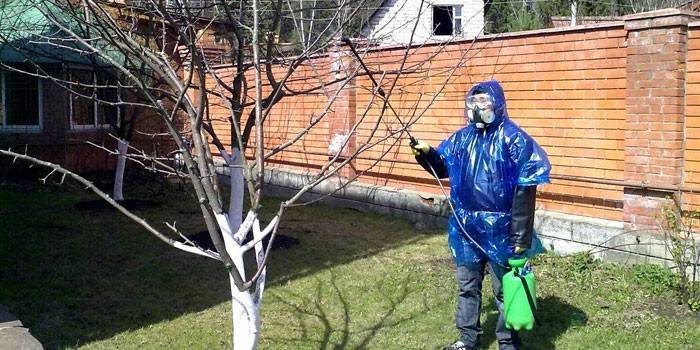
Tree processing
Different types of fruit trees and shrubs are sprayed in different ways. The differences lie in the concentration of the drug, season of the year, frequency of use, consumption rate per tree or bush. Some diseases require repeated spraying. In some cases, pure copper sulfate is used, in others - as part of the Bordeaux mixture, sometimes lime is added.
|
Disease |
Concentration, gram per 10 l of water |
First spraying |
Re-spraying |
|
|
Quince, apple, pear |
Scab, mottling, shrinkage |
100 |
In early spring, before the first buds open |
In autumn, 2 weeks before harvesting |
|
Apricot, plum, cherry |
Mottling, curly leaves |
50 |
In the spring, before the first buds bloom |
End of october |
Rose processing
In autumn, disinfection of rose bushes must be carried out if exacerbations of fungal diseases have been observed during the season. Processing roses increases the immunity of plants, their ability to resist diseases. It should be remembered that spores of the fungus live both on the branches and on the soil around the bush. Therefore, in order to properly process rose bushes, you must:
- Prune and burn dry branches.
- Remove fallen leaves and loosen the ground around the bush.
- Prepare a 3% solution (dilute 30 g of powder in 1 liter of water).
- Spray the plant at the rate of 1 liter per 1 bush.
Grape processing
The autumn sprinkling of grapes with the preparation is especially effective; it is carried out after the harvest is completely harvested and the leaves have fallen off. Copper sulphate serves not only as a protection against fungus, but also as a supplier of a type of iron suitable for plants. A solution of different concentrations is applied to young and old plants. To properly handle the vine, you should:
- Process the vines before winter: remove fallen leaves, cut off dried branches and shorten living ones.
- Prepare a solution based on the following standards: for a young plant 50 g, for an old one - 100 g of powder per 10 liters of water.
- Spray the vine at the rate of 1.5 liters per plant.
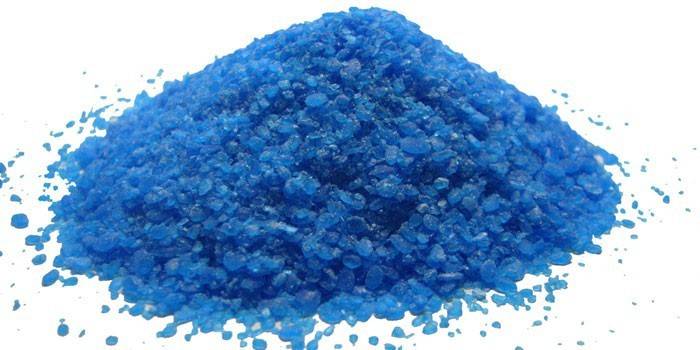
Processing roses in spring
Many gardeners love the beautiful rose. Luxurious buds decorate your site from spring to autumn. However, in order for the rose to endlessly delight our eyes, it needs constant care. This is especially true for the spring processing of roses.
In the spring, you need to remove winter shelters from the rose bushes, install supports, cut the bushes and tie them up. But this is not enough. In order to help our darlings return to life as soon as possible after the winter cold, spring treatment of roses should be carried out. Let's find out what needs to be processed roses after winter.
How to process roses in early spring?
The spring sun is very dangerous, since under its scorching rays you can get very burned. The same applies not only to people, but also to roses: opening them too early can lead to burns. Many gardeners recommend opening roses completely only when the first leaves appear on trees and shrubs. Moreover, the rose bushes must first be opened from the north side, gradually accustoming the plants to the bright sun. After removing the shelter from the roses, you need to uncook them.
In the spring, our most important task is to do everything possible so that the root system of roses works. You can water the ground under the bushes with warm water. And then pour 3-4 liters of urea or ammonium nitrate solution under the bush at the rate of 1 tbsp. spoon for 10 liters of water. Dry fertilizer can be embedded in moist soil, 2-3 g per bush, but keep in mind that liquid fertilizers are still more effective.
If during the winter the shoots of roses are damaged, then the flowers need your help here. Moldy shoots should be washed with a cloth or brush in a solution of potassium permanganate or copper sulfate. If you use potassium permanganate, then make its solution bright pink, and if you decide to use copper sulfate, then use a 1% solution (10 g per liter of water).
In the spring, the treatment of roses can be carried out with full fertilization with microelements. Spread dry fertilizer around the rose bush on damp ground. After that, slightly loosen the soil with a hoe. Then it must be mulched with peat, humus or a mixture of them.
Processing roses in spring from pests and diseases
Beautiful roses, unfortunately, attract the eyes of not only humans, but also various pests. Fungal infection of roses is very common. In addition, caterpillars, ticks, and aphids can attack roses. Therefore, in the spring, as soon as green shoots begin to grow actively, roses should be treated with special preparations. How to treat roses from diseases?
There are many versatile rose disease control products on the market, such as the versatile RoseClear, an insecticide and fungicide combined together. It prevents the appearance of black spots, powdery mildew, rust and aphids.
If you find rusty spots on the leaves, it means that your roses have been attacked by aphids or worms. In early spring, spray the soil under the rose bushes with a 35% solution of ferrous sulfate. For prophylactic purposes, you can treat plants during the budding period with the 15th Bordeaux liquid. If necessary, reprocessing can be carried out after 10-15 days.
When powdery mildew appears on young leaves of a rose, spray the plants with a solution of ash or mullein, which will serve as both fertilizing and fungicide.
For the treatment of rose bushes to be effective, it must be carried out in calm and dry weather. If it's hot outside, treat roses in the evening. This will avoid possible sunburn on the plants. In cool weather, you can do this during the day. This preventive treatment is carried out twice a season: in the spring and after the first period of flowering roses.
When carrying out treatment with such drugs, be sure to observe safety precautions
.
Diseases and pests inflict severe damage and damage to roses, sometimes lead to their death
Therefore, the fight against pathogens and pests should be given exceptional attention. Timely and correct implementation of agricultural techniques and protective measures is the basis for preventive plant protection
Before starting the prevention of crops from diseases and pests, you need to remember about your health. To preserve it, pesticides (pesticides) should be used, observing elementary rules: use respirators, rubber gloves, use drugs only in the prescribed doses. After finishing the treatment of plants, wash your hands and face with soap and water.
Features of spraying roses with iron sulfate in autumn
The first and most important thing that you need to know when using the drug is that the treatment of roses with iron vitriol is carried out in the fall, and not in the spring, as not very experienced flower growers sometimes do. Spring treatment with the agent is acceptable for fruit trees, and then only before bud break
As for roses, spraying the leaves and shoots leads to the formation of brown spots (burns), which are superficial, and do not harm the stems, while the leaves cannot be restored. That is why the treatment of roses is carried out in the fall, after the removal or fall of the leaves.
Ferrous sulfate can be used for any fruit, berry crops, or flowers, but in each case it is necessary to adhere to a certain concentration of the agent. For prophylactic treatment of roses, according to the instructions, a 3% concentration of the drug is recommended - this is 30 g / 1 liter, or 300 g / 10 liters. It is this concentration that experts advise to adhere to when processing bushes in the fall.
It is not recommended to cover wet roses - after processing, the plants need to be given time to dry, and all fallen leaves must be collected and burned. It is not allowed to use ferrous sulfate simultaneously with other fungicides, as well as mixing with lime - this method is mainly used to whitewash the trunks of garden trees, but flower growers who grow roses should also be aware of this.
Garden rose - the queen of flowers - has always been a true decoration of any garden, flower garden. Perhaps there is no such flower bed in which the main place would not be occupied by the luxurious bush of the beautiful rose.
But, since this plant, on the one hand, is perennial, and on the other hand, it is very thermophilic and gentle, careful care is necessary for it.
Unfortunately, rose bushes are highly susceptible to the effects of various fungi, and the fight against them, as you know, requires an integrated approach and constancy.In this review, we will talk about the features of spraying rose gardens with iron sulfate in spring and autumn.
In general, when growing fruit and flower crops, gardeners use a wide variety of fungicidal preparations - all of them are necessary in their own way. Along with the protective properties, vitriol also contributes to a more active, correct development of plants, it can serve as a good fertilizer.
This tool is truly time-tested: iron sulfate has long been used in agriculture. The drug is able to protect roses from the following dangerous diseases:
- gray rot;
- powdery mildew;
- coccomycosis, etc.
In addition, the preparation maintains the iron balance in the soil, saturating the soil with this essential mineral. Thanks to the use of ferrous sulfate, you can:
- protect roses from chlorosis (yellowing of the foliage);
- provoke shrubs for rapid growth of shoots, landscaping;
- activate abundant budding.
How to water / spray with copper sulfate?
Mityai Bukhankin
in order to properly process any plant with any drug, you need to turn the packaging back to you, and start reading the instructions in which it is written in black on multi-colored "Before use, read the instructions" or "Instructions for use" and then it is always written how to apply, dilute and how often. is it hard to do?
;
Copper sulfate, RP
Copper-containing, broad-spectrum contact fungicide.
Active ingredient: copper sulfate, at a concentration of 960 g / kg
Preparative form:
Instant powder.
Purpose: Fungicide for combating diseases of berry, fruit (stone and pome), ornamental crops, shrubs. Designed for use in personal subsidiary plots.
Mode of application:
The estimated dosage of the drug for each culture (see table) is dissolved in a small volume of water in a special container with constant stirring until the drug is completely dissolved. Then the volume of water is brought to the required volume. The working fluid must be prepared immediately before use and used completely on the same day. In the event that the preparation has caked as a result of long-term storage, then before preparation it must be broken up to a homogeneous mass, or dissolved with vigorous stirring.
Before bud break, the plants are sprayed with a freshly prepared working solution in the morning or evening hours in dry (at least 3-4 hours before the rain starts) calm weather, ensuring uniform wetting of the plants. Disinfection of the roots of seedlings of fruit trees and roses is carried out after removing the growths of root bacterial cancer by immersing the roots in a working solution for 2-3 minutes, followed by rinsing with water.
The preparation of the working fluid and the filling of the sprayer are carried out at a distance from residential buildings, cattle yards, sources of water supply and crops of food crops. The working solution is not subject to storage. It is forbidden to mix the preparation Copper sulfate with other preparations.
The consumption of the drug is 50 g per 5 l of water. The multiplicity of treatments - 1. The term of release for manual work (mechanized work) - 3 days (1 day).
Culture
Diseases
Method of processing, consumption of working solution
Apple tree, pear, quince
Scab, phyllosticosis and other spots, moniliosis, curliness
Early spring spraying before bud break. Consumption up to 2 liters for a young tree (up to 6 years), up to 10 liters for a fruiting tree
Apricot, peach, plum, sweet cherry, cherry
Clasterosporosis, coccomycosis and other spots, moniliosis, curliness
Gooseberry Currant
Anthracnose, septoria and other spots
Early spring spraying before bud break. Consumption up to 1 l -1.5 l per bush
the Rose
Black leaf spot, powdery mildew
Spraying in late autumn. The consumption of the drug is 50 g per 1 liter of water. Working fluid consumption - up to 10 l / 100 sq. m
Effective after 2 hours
Protective period: 7-12 days.
Precautionary measures.
Hazard class: 3 (moderately hazardous compound).
The drug is not phytotoxic when used in strict accordance with the developed recommendations, its use does not affect crop rotation. The experience of long-term use of Copper sulfate has shown the absence of resistance to it.
The drug is low-hazardous for bees (hazard class 3)
It is allowed to use the drug in the sanitary zone of fishery reservoirs.
When working with the drug, you must comply with the requirements and precautions. It is forbidden to drink, smoke, eat. When working with the drug, it is necessary to use personal protective equipment for the skin, eyes and respiratory organs: a cotton robe, a hat, goggles, a respirator or cotton-gauze bandage, rubber gloves. Processing should be carried out in the absence of children and pets. Do not use food utensils to prepare the working solution. After work, wash your face and hands with soap, rinse your mouth and change your clothes.
During flowering, processing of plants is prohibited. It is not allowed to enter water bodies, wells, water supply sources. It is impossible to carry out the treatment with the preparation at an air temperature above + 30 ° С. Do not use the drug with an expired shelf life
Lelya Casanova
You can even handle Christmas trees. Usually, Bordeaux trees are 1%, but it is better not to eat fruits this year (in my opinion), and so 2 out of 3 people have fungi: some on the skin, and some in the stomach.


